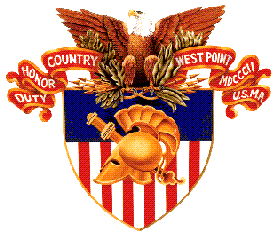It was held this past Sunday evening-perhaps the first on Sunday ever-and
the cadets were in battle dress uniform (BDUs) following a lecture on the
importance of maintaining an appreciation for the military ethos in the
current world situation by the Chief of Staff of the Army, but otherwise it
was a typical Branch Night in the Eisenhower Hall auditorium.
The cadets of
the graduating class already were seated from the earlier lecture, during
which the importance of language training and knowledge of other cultures
also was stressed, so there was no hurried and somewhat anticipatory march
on. The remarks by the Supe, the Com and the Cadet First Captain were
shorter due to the late hour (originally scheduled for 1900 hours-7 pm-it
was about 9 pm before things really got started).
Small, thick envelopes
were passed out by cadet company representatives, holding the insignia of
the branch of the Army that would provide initial training and assignments
for the next several years. Carefully padded, it was impossible to tell by
touch the shape of the collar brass within. For a few, the envelope would
include two insignia-one for their assigned branch and one for the branch to
which they would be detailed for the first two or three years. For fewer
still, the packet would contain Air Force or Marine Corps brass-if they had
a significant tie to the other service prior to becoming cadets. Yes, West
Point has graduated at least one Navy admiral and one in the Coast Guard as
well.
The brass in the envelopes is a gift from the graduated members of the Long
Gray Line as represented by the Association of Graduates and is one of a
number of small gifts presented to each class at various stages in their
cadet careers-including a set of second lieutenant bars bestowed at
Graduation by representatives of the West Point class that graduated fifty
years earlier.
Soon the moment arrived when permission to open the envelopes was granted.
Many, many cries of joy were tempered by a few sighs of resigned acceptance.
The vast majority of cadets received one of their first two choices. In the
past, the Corps of Engineers was coveted by many cadets, and those spaces
went out early. In the dark ages of posted order of merit prior to
computer-aided everything, the number of positions available in each branch
was posted on a blackboard or, later, on the slide of an overhead projector.
The cadets stood up in order of merit and announced their branch selection
from among those available. Each time a branch was selected, the number of
slots available in that particular branch was reduced by one, and the next
cadet in order of merit made his (there were no hers then) choice. The
choices were limited, too. Only the five combat arms-Infantry, Armor,
Engineer, Field Artillery, and Signal Corps-were available. Needless to
say, the highest ranking cadets had five choices, while the class goat
normally was limited to a single option. Now, through the marvels of modern
technology, everything is done by computers, and the results are known to a
few officers on the staff and faculty-sworn to secrecy-somewhat in advance.
While it does not diminish the importance of the event, it does
significantly reduce the inherent nail-biting drama. Will the first man in
the class make the obvious choice of Engineers-or will he make a statement
by choosing the "no time for glory" of the Infantry or the "combat arm of
decision" ethos of the Armor? What branch will the First Captain pick? How
many Air Force fighter pilots hopefuls will get to fly instead of pound the
ground? After all, West Point provided pilots for the Army Air Corps for
decades, essentially functioning as the Air Force Academy does today, and
retained a number of Air Force slots during the transition in the sixties.
How soon will the Artillery run out? What branch will run out last?
Now, of course, the choices truly are daunting. Most every branch has some
slots available, including Finance and the Adjutant General Corps, although
the combat arms still receive the lion's share of newly-minted West Point
lieutenants. A few may even have medical school in their future. Still
others are bound for Oxford or other prestigious graduate schools-some after
a brief stop at their basic branch course. This year, 200 members of the
class will journey to Ft. Benning, GA, to join the Queen of Battle, the
Infantry, while 119 will become Field Artillerymen, another 107 Army
Aviators, 106 will learn tanks in the Armor, 105 will study Combat
Engineering (secondary mission; to fight as Infantry), and 90 will join
Military Intelligence (although 39 of these will be detailed to Armor,
Infantry and other combat arms initially). The Signal Corps claimed 49
(although 19 will be detailed elsewhere initially), 46 chose Air Defense
Artillery, 19 went Transportation Corps, and 18 each selected Military
Police, Quartermaster and the Medical Corps (for medical school). Seventeen
opted for Ordnance, ten each chose the Adjutant General Corps and the
Medical Service Corps, nine went Chemical, and seven selected Finance.
All in all, a quite respectable showing for a class graduating into the
Global War on Terrorism. Lots of infantry, tankers and artillerymen plus
intelligence officers, Apache pilots, satellite communications types and
other support.
Thanks to Gray-Matter and J. Phoenix, Esquire for permission to reprint this account and the Clifton family for their photos
Parents: We would appreciate any photos and memories you may be able to send to us. Please send to the Nobles for inclusion on the page. We need all the help we can get.


